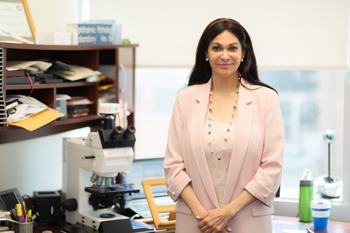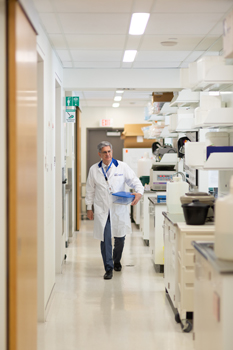Study points to potential new target in glaucoma research

By Ana Gajic

Dr. Neeru Gupta
New research shows the flow of a fluid that surrounds and streams in and out of the eye’s optic nerve with the job of flushing out waste is impaired in glaucoma models. This new study from the Keenan Centre for Biomedical Science (KRCBS) at St. Michael’s Hospital has helped to shed new light on the world’s leading causes of irreversible blindness.
Published in Investigative Ophthalmology & Visual Science, the research builds on a recent finding of the Drs. Gupta and Yucel team with student Emily Mathieu, that fluid around the brain – called cerebrospinal fluid – enters the optic nerve. Before this initial discovery, it was believed that cerebrospinal fluid surrounded the nerve but did not penetrate. Now, the team has uncovered that in a glaucoma model, there is far less entry of the brains fluid into the optic nerve.
“This casts an entirely new light on glaucoma,” said Dr. Neeru Gupta, a clinician-scientist at the KRCBS and co-primary investigator of the study. “If fluid is not getting into a nerve and that fluid exchange – good things getting in, bad things getting out – is disrupted, maybe that’s part of the reason the optic nerve is damaged in glaucoma.”
Glaucoma is often undetected in its onset and once a patient receives the diagnosis, progressive vision loss is inevitable. The disease causes gradual degeneration of the optic nerve. While treatments help to protect vision, currently, there is no cure.

Dr. Yeni Yucel
This is a puzzle Dr. Gupta and her team have dedicated their research to solving. Alongside co-primary investigator Dr. Yeni Yucel, a scientist at the KRCBS and pathologist at St. Michael’s, their team discovered nearly a decade ago that the eye has a lymphatic system, which clears fluid and waste out of tissues. The inability to clear fluid from the eye causes a buildup of pressure, and pressure is the main cause of glaucoma.
“There’s much more to this disease than we would like to think,” she said. “Right now, we are able to tackle pressure in the eye that’s measureable, we drop it, and we slow progression. It’s not a cure.”
The finding that fluid flow into the optic nerve is impeded in lab models is the first step to a new body of research, Dr. Yucel explained.
“Now that we know there’s a problem, we need to drill down to understand the elements of it. It may even explain optic nerve fluid shifts and vision impairment suffered by astronauts in space missions,” said Dr. Yucel, who is also a member of the Institute of Biomedical Engineering Science and Technology of Ryerson University and St. Michael’s.
The next steps for Dr. Yucel, Dr. Gupta, and their team will be to uncover why the flow is disrupted and what impact this has on the optic nerve.
“I see many people who are slowly losing their sight from glaucoma,” Dr. Gupta said. “Despite many of our treatments, it’s sometimes not enough. This discovery potentially offers new hope. As long as we keep looking, there’s hope for a better future for our glaucoma patients.”
These papers are an example of how St. Michael’s Hospital is making Ontario Healthier, Wealthier, Smarter.
About St. Michael’s Hospital
St. Michael’s Hospital provides compassionate care to all who enter its doors. The hospital also provides outstanding medical education to future health care professionals in more than 29 academic disciplines. Critical care and trauma, heart disease, neurosurgery, diabetes, cancer care, care of the homeless and global health are among the Hospital’s recognized areas of expertise. Through the Keenan Research Centre and the Li Ka Shing International Healthcare Education Centre, which make up the Li Ka Shing Knowledge Institute, research and education at St. Michael’s Hospital are recognized and make an impact around the world. Founded in 1892, the hospital is fully affiliated with the University of Toronto.
St. Michael’s Hospital with Providence Healthcare and St. Joseph’s Health Centre now operate under one corporate entity as of August 1, 2017. United, the three organizations serve patients, residents and clients across the full spectrum of care, spanning primary care, secondary community care, tertiary and quaternary care services to post-acute through rehabilitation, palliative care and long-term care, while investing in world-class research and education.
